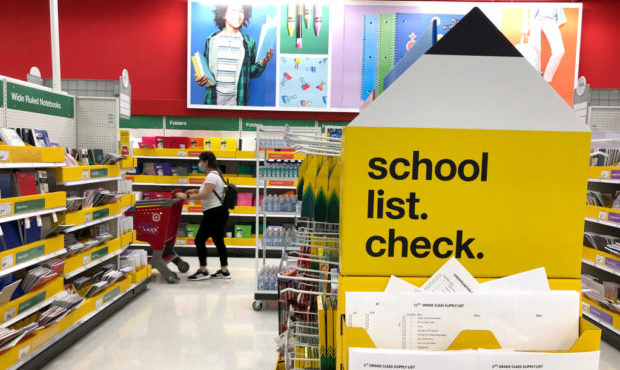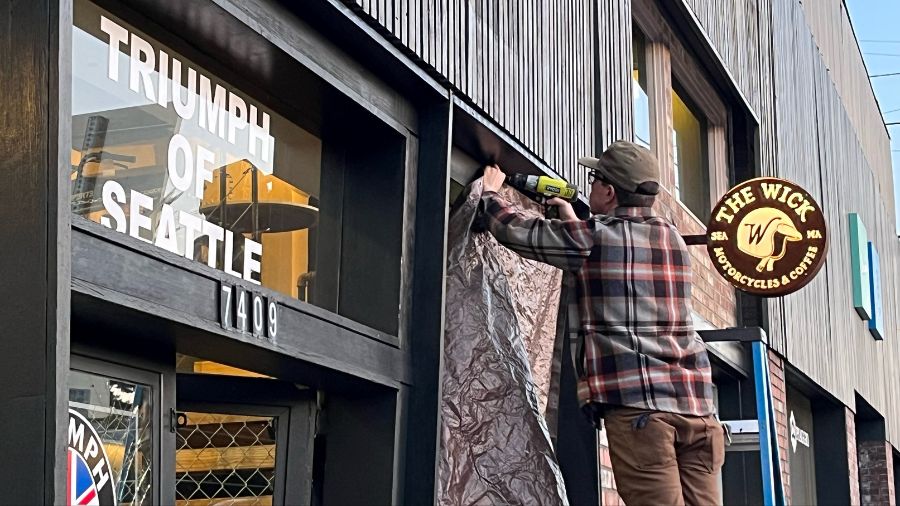Supply chain problems, shortages make back-to-school shopping more challenging
Aug 31, 2021, 6:57 AM

Back-to-school supplies are displayed at a Target store on Aug. 03, 2020 in San Rafael, California. (Photo by Justin Sullivan/Getty Images)
(Photo by Justin Sullivan/Getty Images)
Back-to-school season is in full swing, but getting the kids ready for class again is particularly difficult this year. Supply chain shortages are making back-to-school shopping particularly challenging, especially with families needing more stuff after a year off from “regular” school.
‘Outdoors is safer than indoors’ for school lunch, says local health officer
“I’m excited,” said Hana Mejias, who goes to Echo Lake Elementary.
She said the year of remote learning wasn’t her favorite.
“It was kind of stressful … trying to get online because sometimes it’s glitchy,” she said.
“I’m kind of nervous,” said Georgia Nelson, who is going into the fifth grade. “I don’t remember too much stuff from fourth grade but maybe once I get into fifth grade, I’ll start remembering,” she said.
Nelson said it seemed like she remembered less material because so much of it was online.
But the learning piece is just part of the problem. Getting the kids physically ready with school supplies and clothes is also more difficult.
“That’s what we were just noticing. There’s like slim to nothing in there for shirts and stuff,” said Nick Boston, a Lynnwood parent shopping with his high schooler.
“It’s been crazy. Like there’s nothing in the stores! You almost have to get stuff online — the stores are wiped out,” said Arlene Grayer, a grandparent with her school-aged grandkids in South Seattle.
“Everywhere I’ve noticed things are getting low,” said Jillian Coleman, a Lynnwood mom. “Pants, sweatshirts, some of the socks, underwear — are all sparse.”
Some school PTAs that do all the school supply shopping for students — like at Maple Elementary in Seattle’s Beacon Hill neighborhood — say even finding standard supplies has been tough.
“Some really basic things, like spiral notebooks, are on back order,” said Bao Ng, who is part of the Maple Elementary PTSA.
Ng also said some items have gone up in price. She said a 12-pack of colored notebooks on teachers’ lists used to cost $28.88, but recently jumped to $38.95.
“When the price went up so fast, I was really shocked,” Ng said. “It really hurt me to pay that much knowing some of the money came from families who can barely afford to live — this is money that is contributed from all our families.”
University of Washington’s Foster School of Business professor Jeff Shulman says the same reasons causing supply shortages in other industries are playing out here.
“The products that are getting on the shelves to be sold for back-to-school, those decisions were made before we even knew how many school districts were going to be in person,” Shulman said.
At the time, manufacturers scaled back production. Then, the economy suddenly came roaring back.
“It’s hard to bring people back on board, so it takes a lot of time to fire back production,” Shulman said.
The slowdowns stretch from raw materials to shipping, and impact every step along the way.
Plus, there’s more demand. With a lot of shopping skipped over last year, families just need more stuff for their kids. The National Retail Federation says that, on average, families plan to spend an extra $59 this year.
Further compounding the problem, after struggling to buy what they need in store, people tend to buy more when they do find that item.
“This hoarding mentality: Once you start to hear and see there is scarcity, you start buying more for yourself and more for your friends, and that creates even more scarcity and more panic buying,” Shulman said.
Virologist says it’s ‘not abusive or cruel’ for kids to wear masks at school
A few tips: Get it online; try to buy only what you need; and, if you can, wait for the back-to-school shopping rush to end.
But Shulman says the shortage problem of sporadic items will be sticking around for a while.
“This is unbelievable in the scale of this. We’ve seen disruptions to certain industries or certain products, but to see it across so many products at the same time is just unbelievable,” Shulman said. “So we could see this into 2022.”
By Deedee Sun, KIRO 7 TV













